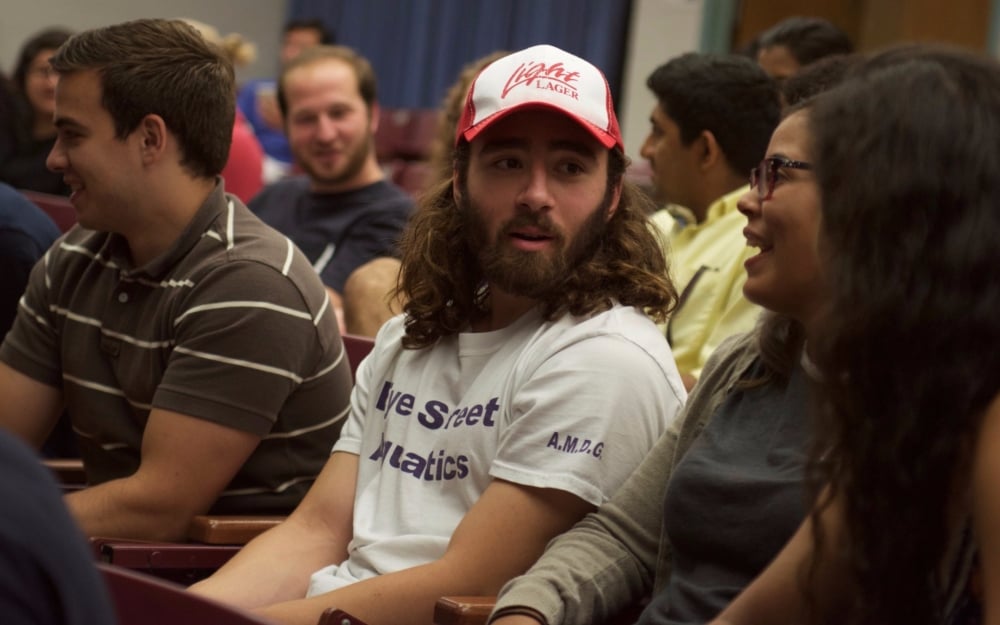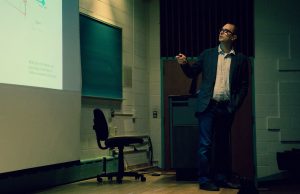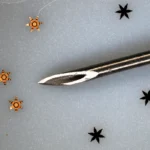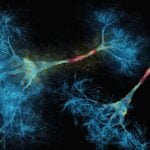Institute for NanoBioTechnology 2017 Summer Seminar Series

Each year 10 undergraduate students participate in the INBT Research Experience for Undergraduates (REU) program. To provide them with opportunities to interact outside of the lab with career researchers, these students engage in many of the same academic and scientific activities as graduate and post-graduate level students. These activities provide professional development and preparedness for the rigors of a research career in nanobiotechnology.
To facilitate learning and exposure to various research fields, the INBT hosts a seminar series with speakers who are leaders in areas such as nanoscience and medicine. For 2017, eight researchers provided in-depth information related to their experience and expertise.

REU students attending the summer seminars
Dr. Taekjip “TJ” Ha, Johns Hopkins University, Bloomberg Distinguished Professor
“Pushing the Limits of Single Molecule Detection Methods Develops State-of-the-Art Biophysical Techniques”
Using multicolor fluorescence, super-resolution imaging, combined force and fluorescence spectroscopy, vesicular encapsulation, single-molecule pull-down, Dr. Ha studies diverse protein–nucleic acid and protein-protein complexes, and mechanical perturbation and response of these systems both in vitro and in vivo.
Dr. Nicholas Maragakis, Johns Hopkins Medicine
“Amyotrophic Lateral Sclerosis (ALS): Mechanisms of Disease and Potential Therapeutic Strategies”
Dr. Maragakis discussed his lab’s pioneering work on mouse models of ALS and current challenges in studying the disease and therapeutic interventions including stem cell transplantation therapies.
Dr. Vipul Periwal, National Institute Diabetes and Digestive and Kidney Disease
“Quantitatively Predicting the Effects of Therapeutic Interventions in Human Disease”
Through graph theory and statistical modeling of mammalian cells, Dr. Periwal and his group have modeled changes in pancreatic islets during development and in type II diabetes patients. These techniques may enable quantitative predictions on the effect of therapeutics in diabetic patients.

Dr. Justin Taraska, National Heart, Lung, and Blood Institute
Dr. Jay Baraban, Johns Hopkins University
“Understanding How the MicroRNA System Effects Synapse Plasticity”
Dr. Baraban presented exciting results on the effects of the microRNA system in neuronal signaling and psychiatric disorders. Specific focus was on translin/trax RNase comoplex and understanding how microRNA systems affect synapse plasticity.
Dr. Jonathan Schneck, Johns Hopkins Medicine
“Engineering the Immune System to Fight Cancer: Bioinspired Design of Artificial Cells & Personalizing Immuno-Therapy”
Cancer immunotherapy by engineering artificial Antigen Presenting Cells (aAPC) is Dr. Schneck’s current focus. He discussed regulatory and exhausted T cells and discussed the techniques that his lab utilizes for nanoparticle delivery.
Dr. Justin Taraska, National Heart, Lung, and Blood Institute
“Imaging the Nanoscale Structure of Plasma Membranes with Correlative Super-Resolution Light and Electron Microscopy”
Dr. Taraska’s research attempts to understand the molecular topology of the plasma membrane using a combination of spectral and electron microscopy techniques. He discussed his lab’s exciting research achievements on imaging Clathrin coated vesicles on HELA cells.
Dr. Jerry Lee, National Cancer Institute
“Advancing Innovation and Convergence in Cancer Research: A Decade of Progress from an Engineer’s Perspective”
As deputy director of NCI, Dr. Lee discussed his role at the Center for Strategic Scientific Initiatives (CSSI), NCIs funding priorities from basic science to translational research and NCI’s big data and personalized medicine initiatives. He provided an overview of the complex landscape and goals of The Cancer Genome Atlas (TCGA) and its pilot studies on glioblastoma (brain), squamous carcinoma (lung), and serous cystadenocarcinoma (ovarian) tumors.
Dr. Steven Jay, University of Maryland
“Uncovering New Insights into Vascular Pharmaceutical Biology and The Design of New Biotherapeutics”
Covering recent insights into vascular pharmaceutical biology and the design of new biotherapeutics, Dr. Jay’s work shows how analytical techniques can be used for mass production of extracellular vesicles from endothelial cells. In the future, these vesicles may be used to encourage angiogenesis in peripheral artery disease patients.
Latest Posts
-
 Johns Hopkins Postdoc Named in Forbes `30 Under 30′ List
December 8, 2025
Johns Hopkins Postdoc Named in Forbes `30 Under 30′ List
December 8, 2025
-
 Micro Grippers: David Gracias Builds Micromachines That Fold, Stick, Swim, and Sense—All Inside the Human Body.
November 20, 2025
Micro Grippers: David Gracias Builds Micromachines That Fold, Stick, Swim, and Sense—All Inside the Human Body.
November 20, 2025
-
 A bold new approach to autoimmune diseases
November 19, 2025
A bold new approach to autoimmune diseases
November 19, 2025


